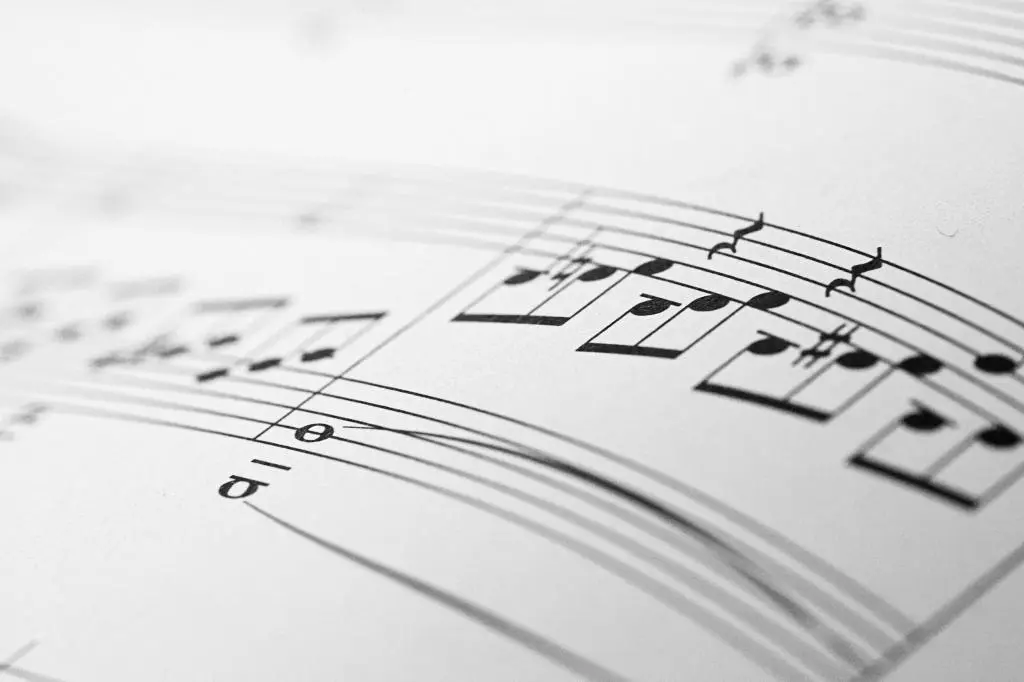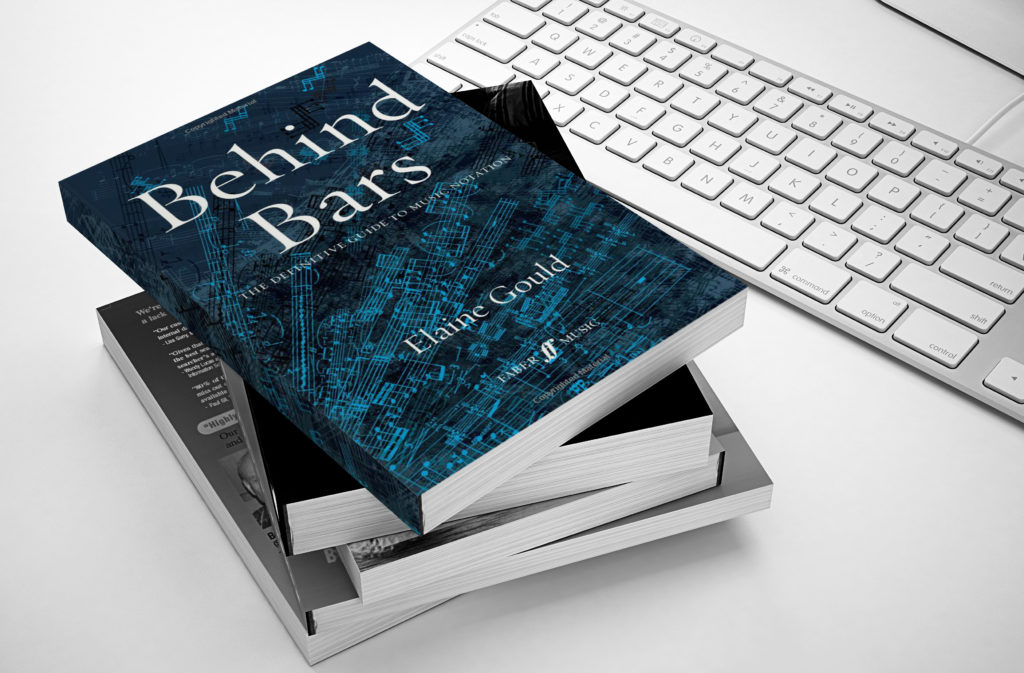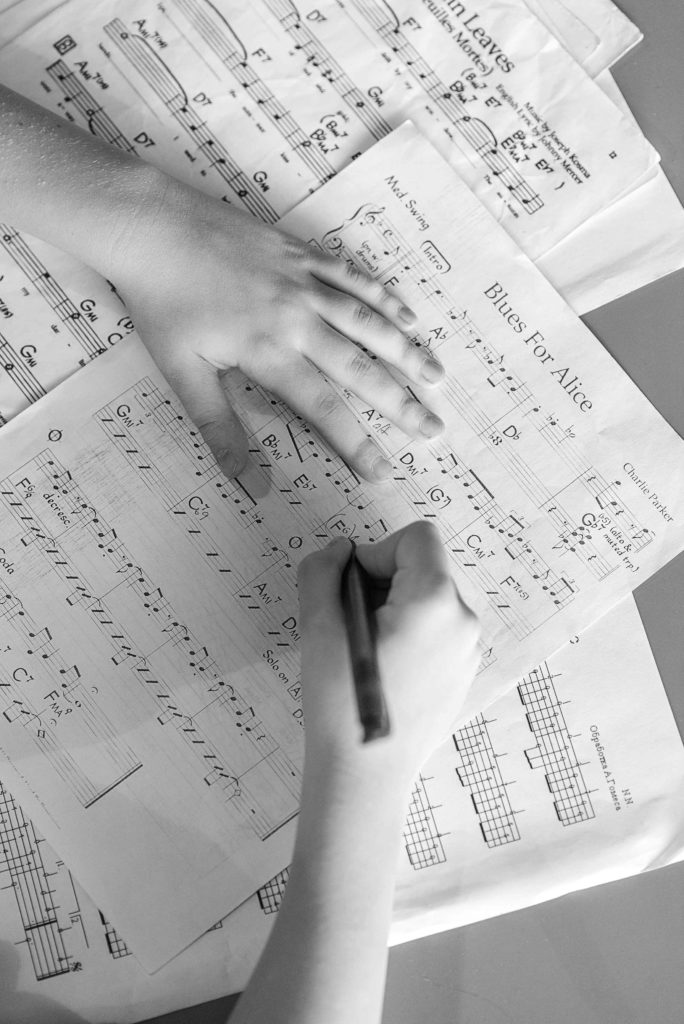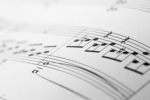A bar is a segment of music that is marked off by vertical lines, called bar lines, and contains a specific number of beats according to the time signature.

What is Bar in Music: Table of Contents
When listening to music, it can be easy to overlook the underlying structure that gives it shape and coherence. However, for musicians and music enthusiasts alike, understanding the concept of a bar in music notation is crucial for analyzing, performing, and appreciating a musical composition. In simple terms, a bar (also known as a measure) is a segment of music bounded by vertical lines, known as barlines. These barlines help to organize musical phrases and create a sense of rhythm and timing in music.
The Basics of Musical Notation
Music notation is a system of written symbols used to represent musical sounds and their duration, pitch, and volume. It serves as a means of preserving and communicating music across time and space, allowing musicians to reproduce a piece of music accurately and consistently.
The most common form of musical notation is sheet music, which typically consists of a staff with a series of musical symbols placed on it. The staff is made up of five horizontal lines and four spaces, and each line and space represents a specific pitch. To determine the exact pitch of a note, a clef is used. There are three main clefs used in Western music notation: the treble clef, the bass clef, and the alto clef.

Musical notes are represented by symbols placed on the staff, and their placement indicates their pitch. The duration of the note is indicated by its shape, with longer notes having a fuller shape than shorter ones. Rests, which indicate periods of silence, are also used in music notation and are represented by different symbols depending on their duration.
There are many different types of music notation, each with its own conventions and uses. For example, tablature notation is often used for stringed instruments like guitars, while drum notation is used for percussion instruments. Graphic notation, which uses symbols and shapes to represent sound, is often used in experimental and avant-garde music. Understanding the basics of musical notation is essential to understanding how bars are used in music.
Understanding Bars in Music Notation
A bar or measure in musical notation is a segment of music that is separated from the rest of the composition by vertical lines called barlines. Bars serve as a way to organize music into smaller, more easily digestible sections and help create a sense of rhythm and timing in the music. Understanding bars is essential for reading and playing music accurately.
Barlines play a crucial role in dividing music into bars. They are vertical lines that appear on the staff, indicating the end of one bar and the beginning of another. Barlines can be single, double, or even dotted, depending on the musical composition. In most cases, barlines indicate recurring beats in the music and help musicians stay in time.
The length of a bar is determined by the time signature. A time signature is a symbol used in musical notation to indicate the number of beats in each bar and the type of note that receives one beat. For example, a time signature of 4/4 means that there are four beats in each bar, and a quarter note receives one beat. Therefore, each bar in 4/4 time would contain four quarter notes or their equivalent.
Other common time signatures include 3/4, which contains three beats per bar, with each beat being a quarter note, and 6/8, which contains six eighth notes per bar, with two groups of three eighth notes each. In 3/4 time, each bar contains three quarter notes, while in 6/8 time, each bar contains six eighth notes or their equivalent.
Different time signatures can create vastly different rhythmic feels, even though the overall tempo remains the same. For example, a piece of music in 4/4 time can feel very different from a piece of music in 6/8 time, even if they are played at the same tempo.
In addition to the standard time signatures, there are also irregular time signatures, such as 5/4 or 7/8, which do not fit into the typical grouping of beats found in more traditional time signatures. These time signatures can create unique and interesting rhythmic patterns in music.
Types of Barlines in Music Notation

In music notation, there are various types of barlines that are used to indicate different things to the musician. Understanding these different types of barlines is crucial in interpreting the music correctly. Here are the most common types of barlines:
- Single Barline: The single barline is the most basic type of barline used in musical notation. It is a vertical line that is used to separate bars or measures in a piece of music. A single barline is used to indicate the end of a bar and the beginning of the next one.
- Double Barline: The double barline is used to indicate the end of a section or the end of a piece of music. It consists of two vertical lines with a thicker line on the left side. A double barline is also used to separate different sections of a piece of music.
- Repeat Signs: Repeat signs are used to indicate a section of music that should be repeated. They are made up of two dots placed before and after a barline. The dots are placed on opposite sides of the barline to indicate whether the section should be repeated from the beginning or the end.
- Mensurstrich: The mensurstrich is a horizontal line that is used to indicate a change in time signature. It is placed above the staff and indicates the end of the current time signature and the beginning of the new one. It is also used to separate different sections of a piece of music.
Common Uses of Bars in Music Notation
Bars play a crucial role in organizing musical phrases and creating a sense of rhythm and timing in music. By dividing music into regular sections, bars help musicians keep time and maintain a consistent tempo. Additionally, bars are used to indicate changes in dynamics, tempo, and other musical elements. In this section, we will explore the common uses of bars in music notation.
One of the primary uses of bars in music notation is to organize musical phrases. By breaking down a musical composition into smaller sections, bars make it easier for musicians to read and perform. For example, in a classical piece, bars may be used to divide a complex melody into smaller, more manageable sections. By doing so, the musician can focus on one section at a time, rather than trying to read and play an entire piece all at once.

Bars are also used to create a sense of rhythm in music. By indicating the time signature and bar length, bars establish a regular pulse that helps musicians keep time. This is particularly important in genres like jazz, where musicians frequently improvise and play off one another. In jazz, bars are often used to create a structure for improvisation, with each musician taking turns playing within the bar structure.
In addition to organizing musical phrases and creating a sense of rhythm, bars are also used to indicate changes in tempo, dynamics, and other musical elements. For example, a piece of music may start with a slow tempo and gradually increase in speed over several bars. Similarly, a piece of music may start with a quiet dynamic and gradually increase in volume over several bars. By using bars to indicate these changes, the composer can ensure that the musicians are playing the music as intended.
The use of bars in different genres of music can vary widely. In classical music, bars are often used to create a structured form, with different sections of the piece separated by barlines. In jazz, bars are used to create a framework for improvisation, with each musician taking turns playing within the bar structure. In pop music, bars are used to create a sense of rhythmic momentum and to help listeners anticipate the next beat or chord change.
Variations in Bar Notation
While bars and barlines form the backbone of most music notation, there are several variations and exceptions that can be encountered in sheet music. These variations help composers and arrangers to convey additional information, including changes in tempo, rhythm, and phrasing.
Dashed or dotted barlines are one such variation in bar notation. These lines are used to indicate a slight pause or hesitation in the music, often used in jazz and other genres where rhythm is an essential component. Dashed barlines are used to indicate a weaker division between bars, while dotted barlines are used to indicate a stronger division. These lines can also be used to show where a song shifts from one section to another.
Another variation in bar notation is the use of multirests. Multirests are used to indicate an extended period of rest, such as multiple bars or even entire pages of rest. Rather than showing individual rests for each bar, a single symbol is used to indicate the length of the rest period. This helps to save space on the sheet music and makes it easier for the performer to read.
In addition to these variations, there are also differences in stress patterns between the different parts of a piece of music. For example, in 4/4 time, the first beat of each bar is typically stressed, while the other beats are unstressed. However, in some genres, such as Latin music, the stress pattern can be shifted, emphasizing different beats.
The history of bar notation is a fascinating one, as it has evolved significantly over the centuries. In medieval times, music notation did not use bars or barlines, and instead relied on a system of neumes to indicate the shape of the melody. It wasn’t until the Renaissance period that bars and barlines started to become more common in sheet music, allowing composers to create more complex and intricate pieces. Today, bar notation is used in virtually all forms of Western music and continues to be an essential tool for composers, performers, and music educators alike.

FAQs about “What is Bar in Music?”
Having gained a preliminary understanding of the concept of “bars” in music, let’s delve further into answering some common questions that have been frequently searched in the section above. This comprehensive FAQ section about “what are music bars” will be regularly updated to provide up-to-date information. If you have any other related topics that you would like to discuss in relation to the article on “what is a bar in music,” please feel free to send them to us. Rest assured that we will strive to provide a prompt and informative response.
Can the number of beats in a bar change in a piece of music?
Yes, the number of beats in a bar can change in a piece of music. This is known as a change in meter or time signature. In music, the time signature indicates the number of beats in a bar and the type of note that receives one beat. Common time signatures include 4/4 (four beats per bar), 3/4 (three beats per bar), 6/8 (six beats per bar), and so on.
However, there are instances where the number of beats in a bar can change within a piece of music. This can happen through the use of irregular or changing meter, where the time signature may switch from one meter to another. For example, a piece of music may start in 4/4 time and then switch to 3/4 time in a particular section or measure, creating a change in the number of beats in a bar. This can add variety and interest to a composition and can be used as a compositional technique to create tension, surprise, or contrast.
It’s worth noting that changes in meter or time signature can sometimes pose challenges for musicians in terms of counting and interpreting the rhythms accurately. Therefore, it’s important for performers and composers to be aware of changes in meter and practice counting and interpreting them correctly to ensure a cohesive and musically coherent performance.
What is a time signature and how does it relate to bars in music?
A time signature, also known as a meter signature, is a musical notation that indicates the meter or rhythmic structure of a piece of music. It consists of two numbers written as a fraction, typically placed at the beginning of a musical staff, just after the clef and key signature. The top number in the time signature indicates the number of beats per bar or measure, while the bottom number indicates the type of note that receives one beat.
The time signature is closely related to bars or measures in music. A bar, also known as a measure, is a segment of music that contains a fixed number of beats as indicated by the time signature. The time signature determines the number of beats that are grouped together to form a bar. For example, in a 4/4 time signature, also known as common time, there are four beats per bar, and the quarter note (1/4) receives one beat. So, in a 4/4 time signature, a typical bar would contain four quarter notes or their equivalent in terms of other note durations, such as half notes, eighth notes, or a combination of different note durations that add up to four beats.
Different time signatures can result in different rhythmic structures and feel in music. For example, a piece of music in 3/4 time signature, also known as waltz time, would typically have three beats per bar, and the quarter note (1/4) would receive one beat. This results in a waltz-like, triple meter feel. On the other hand, a piece of music in 6/8 time signature, also known as compound duple meter, would have six beats per bar, and the eighth note (1/8) would receive one beat, resulting in a compound meter feel with a strong sense of subdivided beats.
How do I determine the time signature of a piece of music?
Determining the time signature of a piece of music involves several steps. Here are some general guidelines to help you determine the time signature:
Look for the time signature notation: The time signature is usually notated at the beginning of a piece of sheet music, just after the clef and key signature. It consists of two numbers written as a fraction (e.g., 4/4, 3/4, 6/8) that indicate the meter or rhythmic structure of the piece.
Observe the top number: The top number in the time signature indicates the number of beats per bar or measure. For example, a time signature of 4/4 indicates four beats per bar, while a time signature of 3/4 indicates three beats per bar.
Observe the bottom number: The bottom number in the time signature indicates the type of note that receives one beat. For example, a time signature of 4/4 indicates that the quarter note (1/4) receives one beat, while a time signature of 6/8 indicates that the eighth note (1/8) receives one beat.
Listen to the music: Pay attention to the rhythmic patterns and accents in the music. Count the number of strong beats per bar and listen for any recurring patterns. This can give you clues about the time signature.
Consider the overall feel: Consider how the music feels or sounds overall. Does it have a steady, marching-like feel with a strong sense of four beats per bar? It may be in 4/4 time. Does it have a waltz-like, flowing feel with a strong sense of three beats per bar? It may be in 3/4 time. The overall feel and character of the music can provide hints about the time signature.
Watch for changes: Keep in mind that some pieces of music may have changes in time signature within the piece, indicating a shift in the meter or rhythmic structure. Be attentive to any changes in the notation or rhythmic patterns as the music progresses.
It’s important to note that determining the time signature of a piece of music may require some practice and experience, especially for more complex or unconventional time signatures. Familiarizing yourself with different time signatures and practicing counting and interpreting rhythms can help you improve your ability to determine the time signature accurately.
What is the difference between a bar and a measure in music?
In music, the terms “bar” and “measure” are often used interchangeably and refer to the same concept. Both terms refer to a segment or a section of music that contains a fixed number of beats, as indicated by the time signature.
A bar, also known as a measure, is a unit of musical organization that helps to organize the rhythm and structure of a piece of music. It is represented visually in sheet music by vertical lines called “bar lines” that separate the music into equal segments. The number of beats in a bar is determined by the time signature, which is a musical notation that indicates the meter or rhythmic structure of the piece.
The term “bar” is more commonly used in British English, while “measure” is more commonly used in American English. However, both terms are widely used and accepted in the field of music, and they refer to the same concept of a segment of music that contains a fixed number of beats, as indicated by the time signature.
How are bars used to create rhythmic patterns in music?
Bars, or measures, are used as a fundamental component in creating rhythmic patterns in music. They provide a framework for organizing and dividing time into regular units, which helps establish the meter or rhythmic structure of a piece of music. Here are some ways in which bars are used to create rhythmic patterns in music:
Time signature: The time signature, represented as a fraction (e.g., 4/4, 3/4, 6/8), indicates the number of beats per bar and the type of note that receives one beat. This establishes the basic rhythmic pattern of the piece. For example, a time signature of 4/4 indicates four beats per bar, while a time signature of 3/4 indicates three beats per bar.
Note durations: Within each bar, different note durations (such as whole notes, half notes, quarter notes, etc.) are used to create rhythmic patterns. The combination of different note durations in each bar creates a unique rhythmic pattern or groove that contributes to the overall feel and character of the music.
Rests: Rests, which indicate moments of silence or absence of sound, can also be used within bars to create rhythmic patterns. Rests are written as symbols or notations in sheet music and are counted as part of the overall duration of a bar. They can be used strategically to create pauses, accents, or syncopations within the rhythm of a piece.
Syncopation: Syncopation is a technique in which accents or stresses are placed on normally weak beats or off-beats within a bar. This creates rhythmic tension and adds complexity and interest to the music. Syncopation can be used to create intricate and syncopated rhythmic patterns within bars, adding a sense of groove or swing to the music.
Repeat signs: Repeat signs are used in sheet music to indicate that a section of music should be repeated. This can create rhythmic patterns through the repetition of specific bars or measures, creating a cyclic or loop-like structure in the music.
Variations: Bars can also be used to create rhythmic variations or patterns by changing note durations, adding embellishments, or altering accents within a repeated musical phrase. This creates rhythmic diversity and interest in the music.
Can bars have different lengths in different sections of a song?
Yes, bars or measures can have different lengths in different sections of a song. This is known as “irregular meter” or “changing meter” in music. In some musical compositions, the time signature or the number of beats per bar may change from one section to another, resulting in bars of different lengths in different sections of the song. This can create a sense of rhythmic variety, complexity, and musical interest.
For example, a song may start with a time signature of 4/4 (four beats per bar) in the verse sections, but then change to 6/8 (six beats per bar) in the chorus sections. This would result in bars of different lengths in the verse and chorus sections, with four beats per bar in the verse and six beats per bar in the chorus. This change in meter can create a distinct rhythmic feel and contribute to the overall musical structure and character of the song.
Changing meter can also be used in more complex ways, such as asymmetrical meters, where the number of beats in a bar is different in each bar or changes irregularly, creating intricate and shifting rhythmic patterns. This can add a sense of unpredictability, tension, and musical interest to a composition.
It is important to note that irregular meter can be difficult for listeners and performers alike since it necessitates close attention to variations in the rhythmic pattern. It can also be artistically employed to enhance a piece of music’s aesthetic expression by adding complexity, variety, and distinctive rhythmic patterns.
What are pickup bars or anacrusis in music?
In music, pickup bars, also known as anacrusis or upbeat, refer to a partial or incomplete bar that occurs at the beginning of a piece of music or a musical phrase before the first complete bar. A pickup bar is a musical device used to create a sense of forward momentum or anticipation, leading into the main body of the music.
A pickup bar typically consists of one or more incomplete beats, where the last beat of the incomplete bar is followed by the first complete bar of the piece. The duration of the pickup bar is subtracted from the total number of beats in the time signature of the piece, so that the first complete bar aligns with the downbeat or the strong beat of the music.
For example, in a piece of music with a time signature of 4/4 (four beats per bar), a pickup bar may consist of only one beat, typically the last beat of the incomplete bar. This would create a sense of anticipation or “pick up” into the main body of the music, which starts on the first complete bar with a strong downbeat.
Pickup bars or anacrusis are commonly used in various musical genres, including classical, folk, pop, and jazz, to create a sense of motion and musical interest at the beginning of a piece or a musical phrase. They can add a sense of rhythmical and melodic tension, leading into the main body of the music and contributing to its overall expressive quality.

